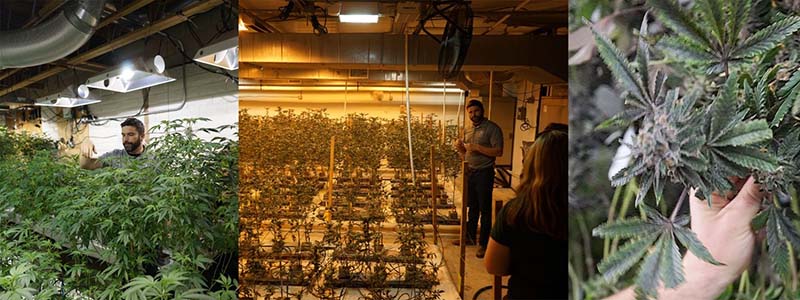
SACRAMENTO – Any cannabis grower can tell you that aphids, mites, molds and a bevy of other pests can decimate even the most carefully tended crop – wasting months of work. But seasoned and budding famers alike should think twice before reaching for a pesticide. That could put you on shaky legal ground, not to mention place employees or customers at risk. What’s a would-be grower to do? Here’s a primer, from Department of Pesticide Regulation (DPR) staff experts.
Can I use any pesticides to grow cannabis?
The answer, at least for now, is mostly no.
To legally sell (or use) a pesticide for anything, the U.S. Environmental Protection Agency (USEPA) must “register” it. Registration follows scientific studies which look at whether the product is effective and how it can be safely used. Out of this process, a “label” is created. The label is the detailed list of instructions you see on, or packaged with, a pesticide container. Labels say how, when and where you can use the pesticide, as well as on what types of pests and plants. Labels are legally enforceable. So, besides potentially harming someone or something, misusing a product can result in hefty fines. Remember cannabis is illegal under federal law, so there is no pesticide specifically registered by the USEPA for use on cannabis.
So you’re out of luck?
Not really. Two possible alternatives are products with broad labels and federally “exempt” products. Some USEPA-registered products have labels that allow use on a wide variety on plants and pests.This could be an option.
“For example, a label that says ‘This can be used on the following crops including but not limited to,’” explained Rachel Kubiak, DPR’s cannabis program supervisor. “However, it’s important for the user to read the entire label because it needs to be read in its entirety before a decision can be made. If someone is unsure, they should check with their county agricultural commissioner.”
Other pest controls that growers could use are so-called “minimal risk” substances, which are exempt from the federal registration requirements. Generally, these are not considered harmful to people or the environment. Examples include clove oil, peppermint or baking soda. While not specifically recommending their use, DPR has posted criteria that includes examples of minimal risk pesticides on the department’s website here. Using products that fit the criteria on your plants wouldn’t violate California law. However, DPR does crack down on manufacturers and distributors of unregistered products that make “pesticidal claims.”
A major reason is to ensure consumers aren’t being duped.
“One problem is a lot of these products haven’t been registered so we can’t confirm they work. We found one that was 99.999 percent water being sold for $30,” Kubiak explained.
What are the rules regarding employee safety equipment?
Products with federally approved labels list what type of personal protective equipment (PPE) is required to be used. Examples of PPE include goggles, gloves, respirators or coveralls. When using a product with no label – like exempt products – employers are still required to supply employees with safety glasses and gloves, per DPR regulations, according to Kevin Solari, a DPR environmental program manager who specializes in worker protection regulations. In addition, employers are also required to provide training on any PPE being used.
DPR and cannabis
You may wonder how DPR’s work differs from other state agencies like the Bureau of Cannabis Control (BCC) or the Department of Food and Agriculture. Cannabis is grown in many counties and so the enforcement of pesticide rules are largely being handled through local county agricultural commissioners. The department and commissioners are applying existing pesticide regulations – the rules long followed by growers of other crops like, say, almonds or tomatoes. However, many cannabis growers are new to the pesticide regulatory system, so many commissioners are focusing on educating growers on state and federal rules. You can check with your county agricultural commissioner’s office for information and to see if they’re offering any classes.
“A lot of the people have never really been in a position where they are responsible for that. They have to follow rules, report use. … They have to do what every normal agriculture business must do, but many have never farmed and they don’t know the rules or how to follow them,” said Kubiak.
DPR’s cannabis program staff study potential pesticide-related environmental issues, like water pollution in sewer systems, aid agricultural commissioners on interpreting and enforcing pesticide regulations as they relate to cannabis, and consult with the state BCC on establishing pesticide limits.
Toward the latter, cannabis products sold in California are tested by the BCC for pesticide residues. To protect humans and the environment, it uses DPR-recommended “action levels” for certain pesticides. If a cannabis sample contains more than the action level, it can result in the cannabis product being unsaleable.
Not all pesticides for which testing is done are legal to use. This has caused some initial confusion
for some growers. Growers are only allowed to use pesticides that are legal (if they use them at all), but the BCC also recognizes that the industry is in its infancy and some products may contain illegal pesticides. “Some people believe that if it’s being tested for that it’s legal to use. That’s not true,” Kubiak explained.
DPR is committed to working with this industry, and with our state and local partners, to ensure that
consumers and workers are protected.
More information on pesticide use and cannabis:
https://www.cdpr.ca.gov/cannabis
Employee safety posters:
https://www.cdpr.ca.gov/docs/cannabis/cannabis_pesticide_safety.pdf
County agricultural commissioner contacts:
http://www.cdfa.ca.gov/exec/county/countymap/
For content questions, contact:
Craig Cassidy
Public Information Officer I
DPR Office of Communications
1001 I Street, P.O. Box 4015
Sacramento, CA 95812-4015
Phone: (916) 445-5815
E-mail: [email protected]
